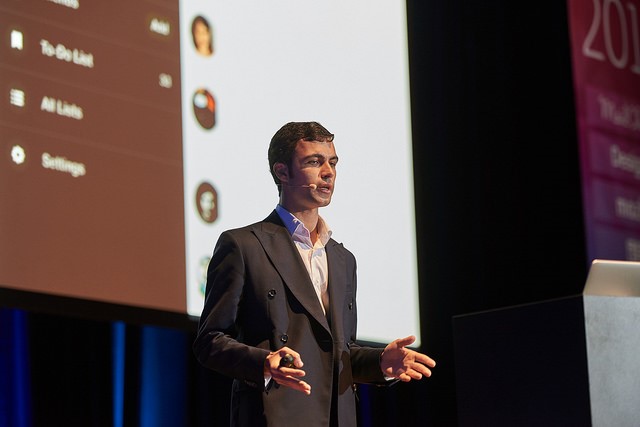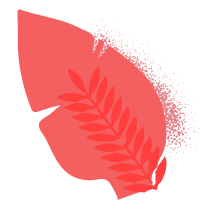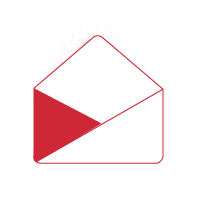
How Nick Babich Pioneered the Web and UX Writer Title
There are four things that designers typically overlook the importance of in their digital work: proofreading, copy or written content, accessibility and user testing. Noticed 50% of these involve writing.
Writing, being sometimes a task we all take for granted in the digital and product design world is of course the basis behind the homo sapien's civilized transformation. Communication of ideas and philosophies within digital design is something that Nick Babich, 30, from Saint-Petersburg, has made a career out of. With over 40 thousand followers on Medium, he has transfered a unique passion for software into instructionals, how-to's, stories about UI, UX, and intricate topics around technology and design, in addition to speaking gigs across the country.
While reading, "Mastering the Power of Nothing" your engulfed in the idea of whitespace and layout. His teaching style, opinionated, yet warm and backed with research, is fostered within a tone that speaks with conviction. Your persuaded in his ideas, such as "you aren't using enough space between your sections", "your layout can always use some color", and "typogoraphy is something both designers and developers need to spend more time on". Today, we are reading: "Communication plays a vital role in design. In order to be successful, your products have to clearly communicate their intent and purpose. When we talk about communication, we usually mean text, because the purpose of any text on your website or app is to establish a clear connection with users. Typography plays a significant role in this process: Good typography makes the act of reading effortless, while poor typography turns users off. As Oliver Reichenstein states in his essay “Web Design Is 95% Typography” - From Nick's piece called, "The Guide to Getting Typogoraphy right in Digital Design".
This unique focus with a career in writing for the technology sector, like most things, has its own drawbacks. Readers that offer him critiques and feedback, while few, at times contain heavy criticism. "Writing is unique for that", Babich says. But his responses are so elevating that rarely do arguments emerge and you find yourself that much more inspired from his points. Nick is known not just for his opinion pieces and tutorials but also for the research behind them, "Detailed analysis of a major e-commerce sites found that 45% of all customers had multiple registrations in the system, 160,000 people requested their password every day, and 75% of these people never completed the purchase they started once they requested their password. Bottom line, log-in is a big deal — big enough that most sites and applications have started exploring new designs solutions for the problem." - Taken from "The Most Common Log-in Problems and Solutions" by Babich.
Sitting down with Nick, we understand more of his methods, his early beginnings and why content creation, in his opinion, should be every designer's next main focus:
Can we first talk about your time as a developer / designer hybrid, before writing and public speaking?
I was born in the far-east region of Russia called Sakhalin. It’s an island near the Japan. I spent all my childhood there and in the age of 16, I’ve moved to Saint-Petersburg. Now I’m living in Saint-Petersburg, Russian Federation.

Since my early childhood, I was fascinated by design. I constantly seek for inspiration and found it both in nature and in everyday things. Cars are one of the most significant sources of inspiration for me. I can literally spend hours looking on cars silhouettes in attempt to find the beauty of lines. This love I’ve got from my father, who is a big fan of cars. One of the cars my father owned in late 80s - beginning for 90s.

My path into UX design is a slightly unusual one. I started as a software developer more than 10 years ago. Starting out as a software developer was a great opportunity to go deeper into the industry and understand how to solve complex problems. Both design and development fields are familiar to me since I work with developers and designers on a regular basis.
Can you elaborate on your early education?both high school and/or college? Were you working during this time?
My early education wasn't too specific, but it was truly valuable for me. A lot of my school and college teachers were people who were sources of inspiration. When I moved to Saint-Petersburg I decided to study software development. I’ve got an MSc in Computer Science.
I majored in Computer Science at university, and during that time I realized that software design and development go side by side when we want to create great products. The most important thing is that we need to understand how the product will be used in the end. So I came to the importance of user experience. The more I learned, the more interested I became in UX design. I wanted to bring all the beautiful things in the world via my articles.
You have written for Smashing Magazine, CreativeCloud, NetMagazine Shopify, Tech in Asia, UX Booth, Speckyboy, UX Planet, Usersnap and more, can you talk about how you got in to the writing space?
During my university years, I formed a habit of collecting notes on design and development. This habit evolved when I started working on real-life projects. One day, Igor, a good friend of mine, gave me the advice to share what I've learned with other people and that’s how I started blogging. The first months of blogging was a time of constant experimentation in an attempt to find my own style. But after a while, I created my own writing style which I follow now.
What has been your favorite platform or client to write for?
I love writing on Medium. It’s my favorite platform. The way Medium’s team focus on UI design (especially typography) is simply amazing. In fact, my latest article about whitespace was inspired by Medium.

Out of all of the industry topics, you seem to lean on design, touching on colors, UI and UX techniques, the mechanics in story boarding and layout. Are you more drawn to design than development? What is more important (design or development)?
I can’t say that I more drawn to design than development. In fact, I think that both design and development are essential for me, and I feel great that I have an opportunity to work in both fields. It might sound strange, but I believe that development is a part of the design too. Writing code is design — we create a model in our mind and make it “alive” using code. Today, the boundaries between design and development are blurring and many designers learn how to code.
You have publicly made a promise to write 5 articles a month. How is that going, and what have been your favorite article so far?
Yes, and now I write more than 5 articles a month. My favorite time for writing articles is early morning or late evening when I can concentrate. The most favorite articles for me are fundamental articles on UX design (such as What is UX), best practices for UX/UI design (mobile design best practices) and career advice (how to evolve from UX designer to Product Designer).
Touching on your process, what is your writing routine or process like? Is it different when you're writing for clients?
Writing an article is the same as designing a product for me. The same process of RIPT (Research; Ideate; Prototype; Test) that I use for creating a product works for writing. Testing phase in case of writing is reading and responding to reader's comments.

I use the same process when writing for clients since I believe that it’s essential to follow your own style in writing.
Are you collaborating with other designers and developers during these pieces?
Of course. I believe that collaboration is essential for anyone in design/development field. I myself often seek for advice or give constructive criticizing when someone asks for my opinion.
Getting into speaking, how has than experience been?
That was fun. One day I’ve got an email from one big conference in Germany (Push Conference) and they were interested in having me speak at the conference. I’ve sent a draft of what I wanted to talk about (UX of navigation) and they invited me. It was an amazing experience to me.
As both an observer and an experience developer/designer, what is the most troubling thing that we see large companies, Google, Facebook, Uber, on and off the screen facing?
We live in a great time. We have so many changes in our environment that make our life better. But at the same time, this is a great challenge for big companies. The nature of constant evolution requires company to move fast and quickly adjust to the changes. That’s why we see Uber that try to use self-driving cars, Google that tries to bring innovation in many fields (successfully or not).
What is the most exciting thing (previous question)?
Great question. I can answer here both in terms of technology and UX process:
New technologies. I believe that our industry is moving towards Augmented reality and Virtual reality. AR/V is our future. I think that these two mediums will bring a lot of benefits for users. Business, education, medicine, entertainment — almost all spheres can benefit from these. As for us, designers and developers, this will be exciting and fun to explore these mediums like using Microsoft Hololens for education.

Design process. Most probably you’ve noticed a rise of tools that allow collaboration between designers and developers. I think that tools that bridge the gap between designers and developers and make collaboration process easy are simply essential for business needs. Designers and developers often work with compressed timeframes and multiple projects simultaneously. They must be able to respond quickly to feedback on their product from clients, project managers, and developers. This type of tools makes it possible to both simplify and speed up the design and development process.
What other trends are you seeing for the future of design?
Accessibility. I think it will be a big trend in the nearest future. With the rise of web service/mobile apps/IoTs, more and more users from different categories will use digital products on a regular basis, and all of them should be able to use products without any problems. Designers will strive to create the best possible experience for anyone who’ll use the product.
And of course, what is the future like for you? What projects are you excited for?
Personally, I’m excited about electric car industry. Tesla’s Model S pioneered on this new market, and I’m sure that we’ll have more competition and innovation in this sphere. This is a great example of how everyday things around us changing and become more sophisticated and easy-to-use at the same time.
If you were to guide a young digital designer entering writing as career pivot, what advice would you give them?
I have a few recommendations. First, find what inspires you. That might be people, projects, technologies, etc. This will help you to define focus for your writing. Next step is to find a relevant topic (or topics). The most important thing to remember when selecting topics for your writing is to choose the topics that will be helpful for your readers. Last but not least, experiment with your writing style. Try different style of articles, find the one that you feel the best for you. And if something not working, no problem, just iterate out of it.




